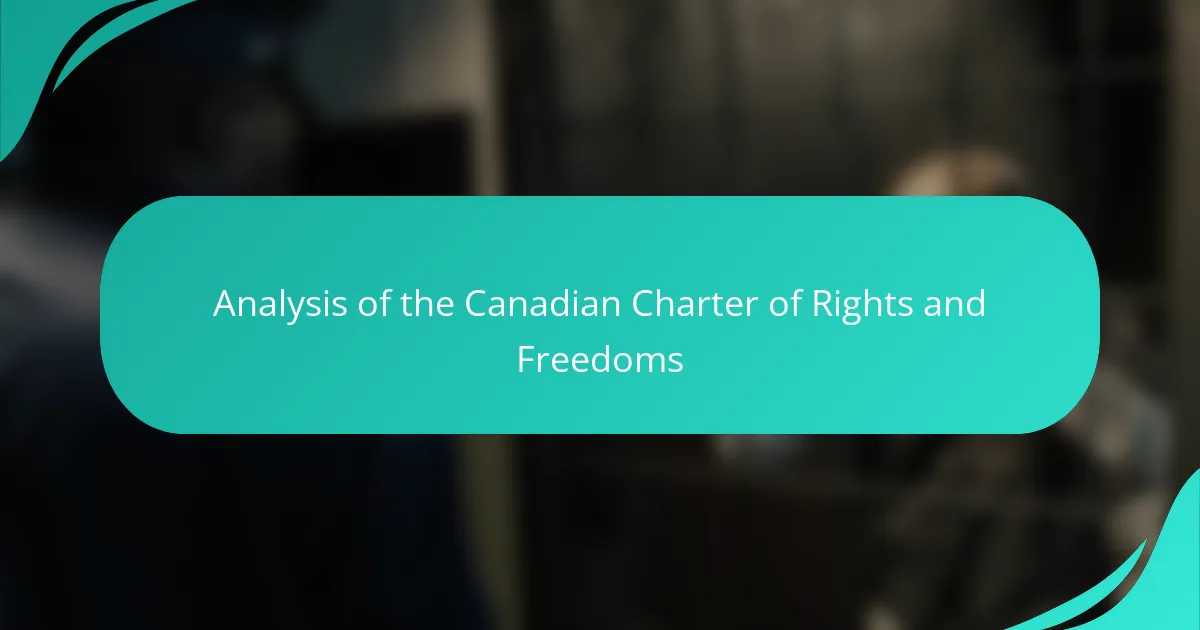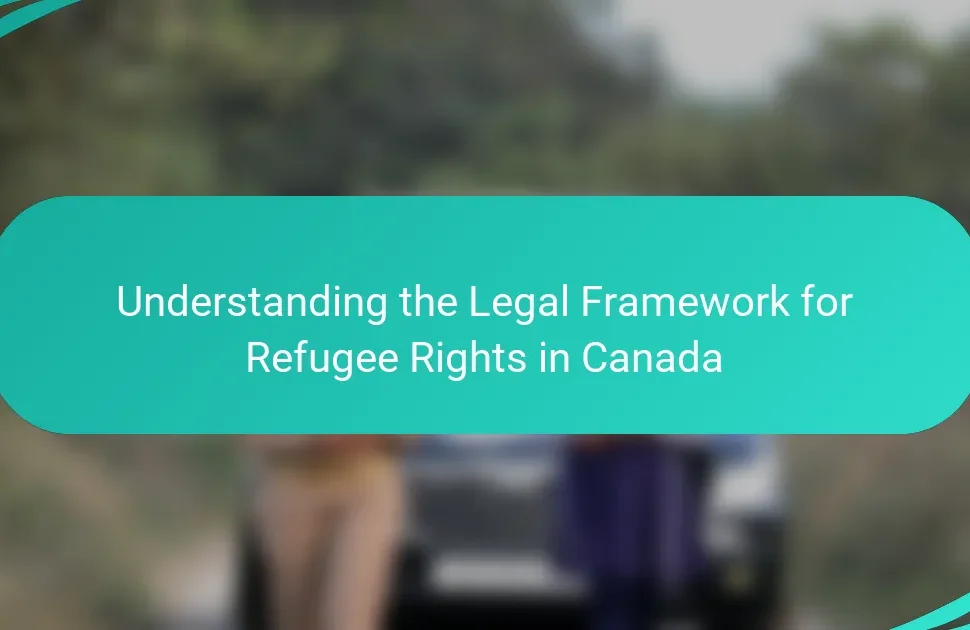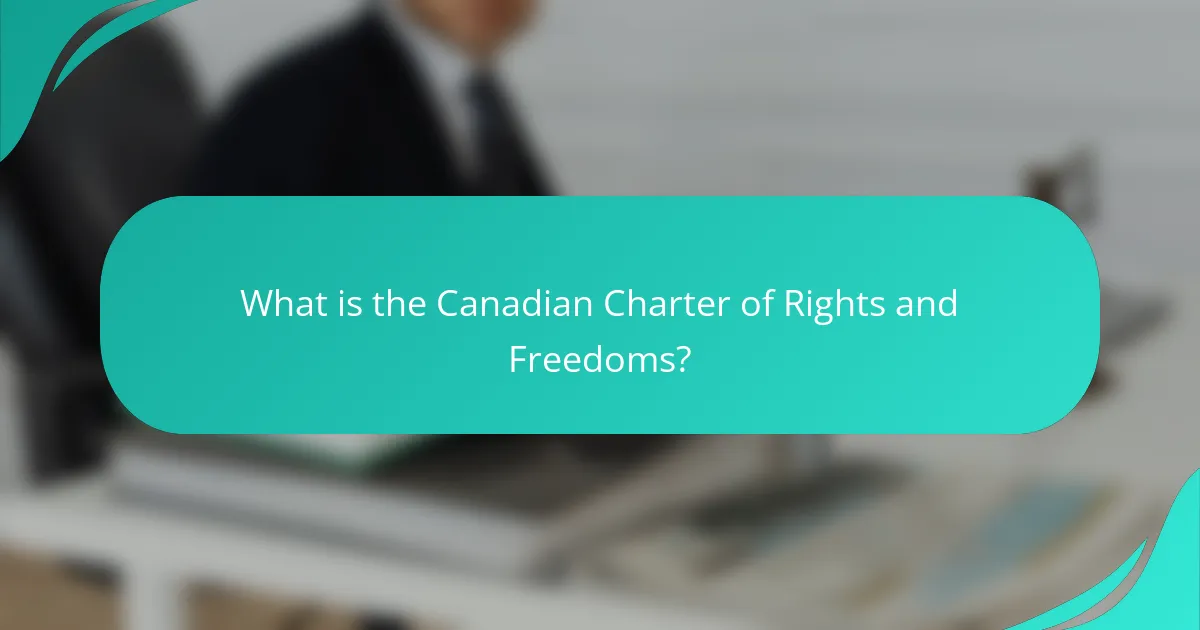
What is the Canadian Charter of Rights and Freedoms?
The Canadian Charter of Rights and Freedoms is a constitutional document that guarantees fundamental rights and freedoms to all Canadians. It was enacted in 1982 as part of the Constitution Act. The Charter outlines various rights, including freedom of expression, the right to a fair trial, and equality rights. It applies to all levels of government in Canada. The Charter also includes provisions for the protection of minority rights and the right to participate in democratic processes. It serves as a critical framework for assessing laws and government actions. The Supreme Court of Canada interprets the Charter to ensure compliance with its principles. The Charter has significantly influenced Canadian law and society since its introduction.
How was the Canadian Charter of Rights and Freedoms created?
The Canadian Charter of Rights and Freedoms was created through the patriation of the Constitution in 1982. This process involved negotiations between the federal government and the provinces. Prime Minister Pierre Trudeau played a significant role in advocating for the Charter. The Charter was included in the Constitution Act, 1982, which was passed by the Parliament of Canada. It aimed to protect individual rights and freedoms in Canada. The Charter reflects values such as equality, freedom of expression, and legal rights. It was inspired by similar documents in other democracies. The creation of the Charter marked a pivotal moment in Canadian constitutional history.
What historical events led to the development of the Charter?
The Canadian Charter of Rights and Freedoms was developed in response to historical events that highlighted the need for protecting individual rights. The 1960 Canadian Bill of Rights marked an early attempt to safeguard civil liberties. The Quiet Revolution in Quebec during the 1960s emphasized demands for social justice and equality. The 1970 October Crisis demonstrated the tension between national security and civil liberties. The constitutional discussions in the late 1970s and early 1980s, particularly under Prime Minister Pierre Trudeau, aimed to patriate the Constitution. The result was the Constitution Act of 1982, which included the Charter. These events collectively underscored the necessity for a formalized set of rights in Canada.
Who were the key figures involved in drafting the Charter?
The key figures involved in drafting the Canadian Charter of Rights and Freedoms include Pierre Elliott Trudeau, Jean Chrétien, and Gérard La Forest. Pierre Elliott Trudeau was the Prime Minister at the time and played a significant role in its introduction. Jean Chrétien, as the Minister of Justice, was instrumental in the legal framework of the Charter. Gérard La Forest contributed as a legal advisor and was influential in shaping its provisions. Their collaboration led to the Charter’s adoption in 1982, which aimed to protect individual rights and freedoms in Canada.
What are the main components of the Canadian Charter of Rights and Freedoms?
The main components of the Canadian Charter of Rights and Freedoms include fundamental freedoms, legal rights, equality rights, and language rights. Fundamental freedoms encompass freedom of expression, assembly, and religion. Legal rights protect individuals against arbitrary detention and ensure fair trial rights. Equality rights guarantee equal protection and benefit of the law without discrimination. Language rights provide the right to use English or French in federal institutions. These components collectively safeguard individual liberties and promote justice in Canada.
What rights and freedoms are guaranteed by the Charter?
The Canadian Charter of Rights and Freedoms guarantees fundamental rights and freedoms to all Canadians. These include freedom of expression, freedom of assembly, and freedom of religion. The Charter also ensures the right to a fair trial and protection against unreasonable search and seizure. It prohibits discrimination based on race, gender, or disability. Additionally, it protects the rights of minorities and guarantees legal rights. The Charter is a key component of Canada’s Constitution, enacted in 1982. It serves to uphold democratic values and individual liberties.
How does the Charter protect individual rights?
The Charter protects individual rights through various provisions that guarantee fundamental freedoms. These include freedom of expression, freedom of assembly, and the right to a fair trial. The Charter applies to all levels of government, ensuring that laws and actions respect these rights. Section 1 of the Charter allows reasonable limits on rights, but only if justified in a free and democratic society. Courts interpret and enforce these rights, providing a legal framework for individuals to challenge violations. Landmark cases, such as R v. Oakes, demonstrate how the Charter is applied in practice. The Charter has had a significant impact on Canadian law and society, reinforcing the importance of individual rights.
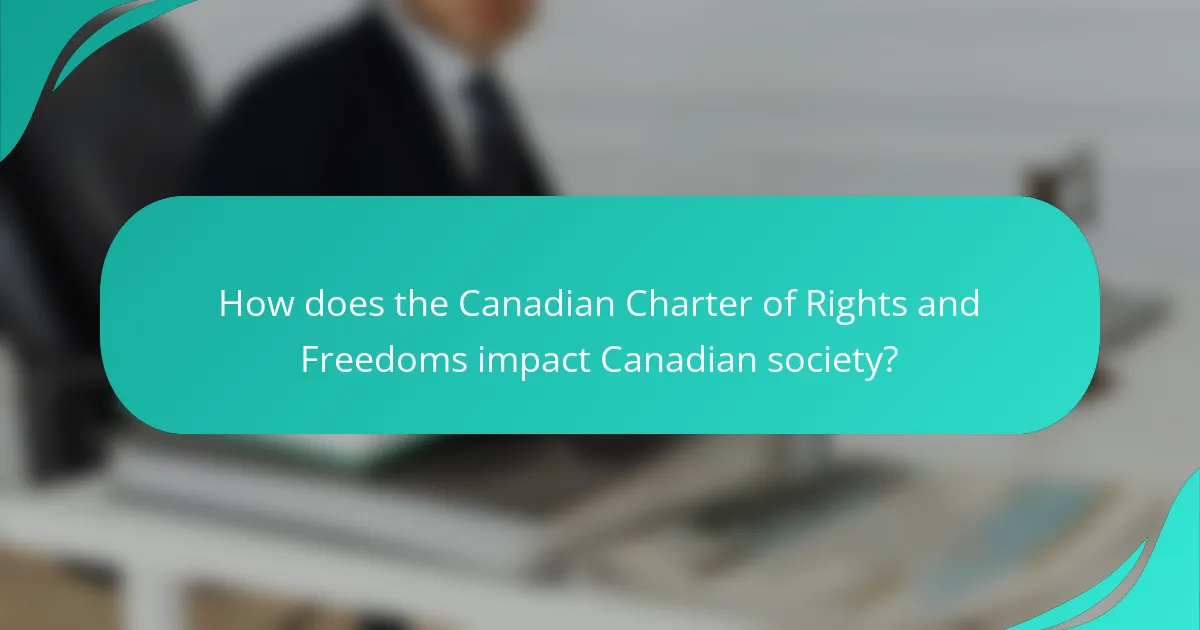
How does the Canadian Charter of Rights and Freedoms impact Canadian society?
The Canadian Charter of Rights and Freedoms significantly impacts Canadian society by safeguarding individual rights and freedoms. It establishes fundamental rights such as freedom of expression, freedom of assembly, and the right to equality. These rights empower citizens to engage in democratic processes and hold the government accountable. The Charter influences legal decisions and policies, ensuring that laws align with human rights standards. It has led to landmark Supreme Court cases that shape social justice and equality in Canada. For example, the Charter has been instrumental in advancing minority rights and gender equality. Its provisions promote a culture of respect for diversity and inclusion within Canadian society. The Charter also reinforces the rule of law, which is essential for a functioning democracy. Overall, the Canadian Charter of Rights and Freedoms is a cornerstone of Canadian identity and governance.
What role does the Charter play in Canadian law?
The Charter plays a crucial role in Canadian law by protecting individual rights and freedoms. It serves as the supreme law of Canada, meaning all laws must align with its provisions. The Charter guarantees fundamental freedoms such as freedom of expression and freedom of assembly. It also ensures legal rights, including the right to a fair trial. Courts are empowered to strike down laws that violate the Charter. The Charter has been instrumental in landmark legal decisions, shaping Canadian society. For example, the Supreme Court of Canada has cited the Charter in numerous rulings to uphold civil liberties. Its influence extends to government actions, promoting accountability and transparency.
How does the Charter influence court decisions?
The Charter influences court decisions by establishing fundamental rights and freedoms that courts must interpret and apply. It serves as a legal framework for assessing whether laws and government actions comply with constitutional standards. Courts frequently reference the Charter in rulings to protect individual rights, such as freedom of expression and equality. For example, in R v. Oakes (1986), the Supreme Court of Canada developed the Oakes test to determine if a law unjustifiably infringes on Charter rights. This case illustrates how the Charter shapes judicial reasoning and outcomes. The Charter’s provisions guide judges in balancing individual rights against societal interests. Overall, it significantly impacts legal interpretations and the protection of citizens’ rights in Canada.
What are some landmark cases related to the Charter?
Landmark cases related to the Canadian Charter of Rights and Freedoms include R. v. Oakes, R. v. Morgentaler, and R. v. Butler. R. v. Oakes established the test for reasonable limits on rights. This case clarified the application of Section 1 of the Charter. R. v. Morgentaler addressed abortion rights under Section 7. The Supreme Court ruled that laws restricting access to abortion were unconstitutional. R. v. Butler focused on freedom of expression under Section 2. The court determined that obscenity laws must balance protection and expression. These cases significantly shaped the interpretation of the Charter. They demonstrate the evolving nature of rights in Canada.
Why is the Charter important for Canadian citizens?
The Charter is important for Canadian citizens because it guarantees fundamental rights and freedoms. It protects individuals from discrimination and ensures equality before the law. The Charter also safeguards freedoms such as expression, assembly, and religion. It provides a legal framework for challenging government actions that violate rights. Since its adoption in 1982, the Charter has shaped Canadian society by promoting justice. Courts use the Charter to interpret laws and protect citizens’ rights. This has led to landmark rulings that enhance civil liberties. Overall, the Charter is a cornerstone of democracy in Canada.
How does the Charter promote equality and justice?
The Charter promotes equality and justice by enshrining fundamental rights for all individuals. It prohibits discrimination based on race, gender, age, and other characteristics. Section 15 specifically guarantees equality rights. This section states that every individual is equal before and under the law. It ensures equal protection and benefit of the law without discrimination. The Charter also provides mechanisms for legal recourse. Individuals can challenge laws that violate their rights in court. This promotes accountability and justice within the legal system. Overall, the Charter serves as a framework for protecting individual rights and promoting social justice in Canada.
What are the implications of the Charter for marginalized groups?
The implications of the Charter for marginalized groups include enhanced legal protections and recognition of rights. The Charter guarantees fundamental freedoms, equality rights, and protection against discrimination. These protections empower marginalized communities to challenge injustices in courts. For instance, Section 15 of the Charter specifically addresses equality before the law. It prohibits discrimination based on race, gender, disability, and other grounds. This has led to landmark rulings that support the rights of Indigenous peoples and racial minorities. Additionally, the Charter fosters a culture of inclusivity and social justice. It encourages governmental accountability to uphold the rights of all citizens. Overall, the Charter serves as a crucial tool for advocating for the rights of marginalized groups in Canada.
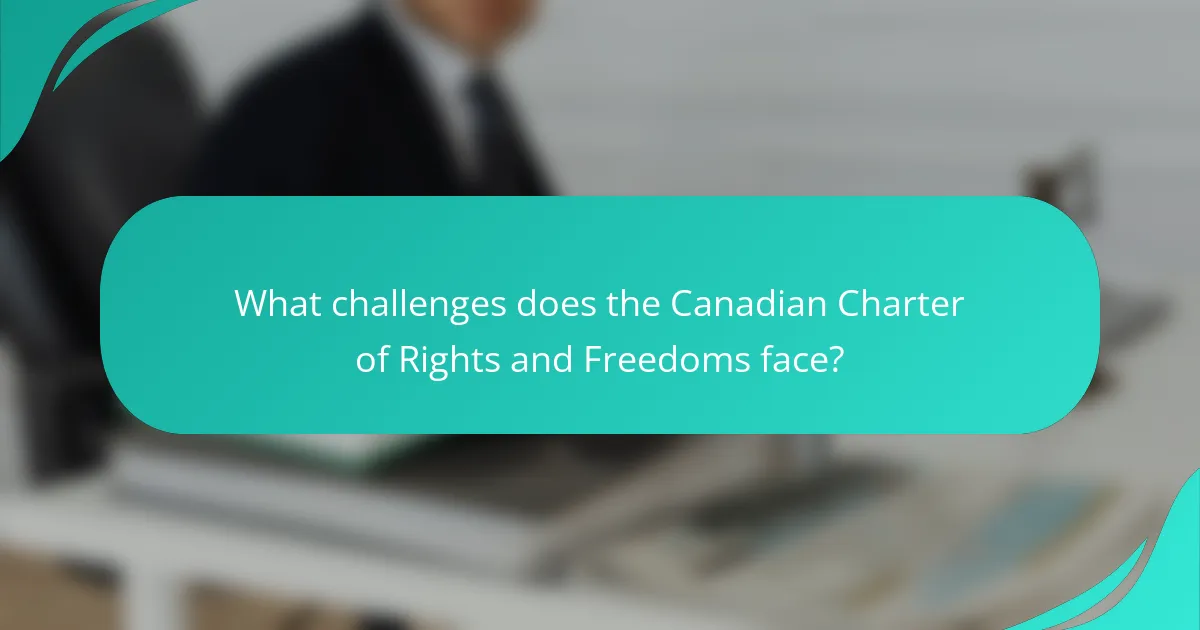
What challenges does the Canadian Charter of Rights and Freedoms face?
The Canadian Charter of Rights and Freedoms faces several significant challenges. One challenge is the interpretation of rights, which can vary among courts. This leads to inconsistencies in how rights are applied. Another challenge is balancing individual rights with collective security. National security concerns can sometimes override personal freedoms. Additionally, there are ongoing debates about Indigenous rights under the Charter. Many Indigenous groups feel that their rights are inadequately addressed. Furthermore, socio-economic rights are not explicitly included in the Charter, leading to calls for reform. These challenges highlight the need for ongoing dialogue and potential amendments to the Charter.
How has the interpretation of the Charter evolved over time?
The interpretation of the Canadian Charter of Rights and Freedoms has evolved significantly since its enactment in 1982. Initially, courts focused on a narrow interpretation of rights. Over time, the courts expanded their understanding of the Charter’s provisions. Landmark cases, such as R. v. Oakes in 1986, established a more robust framework for analyzing rights. The Supreme Court began to adopt a more liberal approach, emphasizing the importance of societal values. This shift allowed for greater protection of minority rights and freedoms. Additionally, the interpretation has adapted to changing social contexts and norms. Ongoing judicial review continues to refine the application of the Charter. Overall, the evolution reflects a dynamic legal landscape responsive to contemporary issues.
What are some criticisms of the Charter’s application?
Criticisms of the Charter’s application include limitations in protecting minority rights. Critics argue that the Charter often favors majority interests over those of marginalized groups. This can result in inadequate legal protections for Indigenous peoples and racial minorities. Additionally, the application of the Charter can lead to inconsistent judicial interpretations. Courts may vary in their rulings on similar cases, creating uncertainty in legal outcomes. Some also claim that the Charter’s reliance on judicial review can undermine democratic processes. Critics believe this may shift power away from elected representatives. These criticisms highlight ongoing debates about the Charter’s effectiveness in promoting equality and justice.
How do societal changes impact the Charter’s relevance?
Societal changes significantly impact the relevance of the Charter. As societal values evolve, the interpretation of the Charter adapts. For instance, increased awareness of human rights issues has led to broader interpretations of rights. Changes in demographics can also influence which rights are prioritized. Legal precedents often reflect these societal shifts, showcasing the Charter’s adaptability. The courts have recognized the importance of inclusivity in their rulings. This responsiveness ensures the Charter remains applicable to contemporary issues. Therefore, societal changes directly shape the Charter’s application and interpretation.
What future developments could affect the Canadian Charter of Rights and Freedoms?
Future developments that could affect the Canadian Charter of Rights and Freedoms include legislative changes, judicial interpretations, and societal shifts. Legislative changes may arise from new laws that expand or limit rights. For example, proposed laws addressing digital privacy could redefine personal freedoms. Judicial interpretations by the Supreme Court can also reshape the Charter’s application. Historical cases, such as R v. Oakes, demonstrate how court rulings influence rights. Additionally, societal shifts, such as increased advocacy for marginalized groups, may lead to amendments. Public opinion can drive political action, affecting the Charter’s evolution. These factors collectively shape the future landscape of rights in Canada.
What ongoing debates surround the Charter?
Ongoing debates surrounding the Canadian Charter of Rights and Freedoms include issues of interpretation, application, and scope. One major debate focuses on the balance between individual rights and collective security. This includes discussions about freedom of expression versus hate speech regulations. Another debate centers on Indigenous rights and how the Charter applies to First Nations. Critics argue that the Charter does not adequately protect Indigenous sovereignty. Additionally, there are ongoing discussions regarding the rights of marginalized communities. The effectiveness of the Charter in addressing systemic discrimination is frequently questioned. These debates highlight the evolving nature of rights in Canadian society. They reflect changing social values and legal interpretations over time.
How can citizens advocate for their rights under the Charter?
Citizens can advocate for their rights under the Charter by understanding its provisions. They should educate themselves about their rights and freedoms outlined in the Charter. Citizens can participate in public discussions and forums to raise awareness. Engaging with local representatives and government officials is also crucial. They can join advocacy groups that focus on specific rights issues. Filing complaints or legal challenges when rights are violated is another method. Utilizing social media platforms to spread awareness can amplify their voices. Documenting experiences of rights violations can provide evidence for advocacy efforts.
What are practical ways to engage with the Canadian Charter of Rights and Freedoms?
Engaging with the Canadian Charter of Rights and Freedoms can be achieved through several practical methods. Individuals can educate themselves about their rights and freedoms as outlined in the Charter. Attending workshops or seminars on constitutional rights is beneficial. Participating in community discussions can foster a deeper understanding of the Charter’s implications. Advocacy groups often provide resources and support for citizens to learn about their rights. Additionally, individuals can engage in civic activities, such as voting, to exercise their democratic rights. Utilizing social media platforms to raise awareness about the Charter promotes public discourse. Lastly, consulting legal experts for advice on Charter-related issues ensures informed engagement.
The Canadian Charter of Rights and Freedoms is a constitutional document enacted in 1982 that guarantees fundamental rights and freedoms to all Canadians, including freedom of expression, the right to a fair trial, and equality rights. This article analyzes the Charter’s creation, its historical context, key figures involved, and its main components, such as legal and language rights. It also explores the Charter’s impact on Canadian society, its role in law, landmark court cases, and the challenges it faces, including debates surrounding its interpretation and application. Additionally, the article discusses the importance of the Charter for citizens, particularly marginalized groups, and outlines practical ways for individuals to engage with and advocate for their rights under the Charter.
